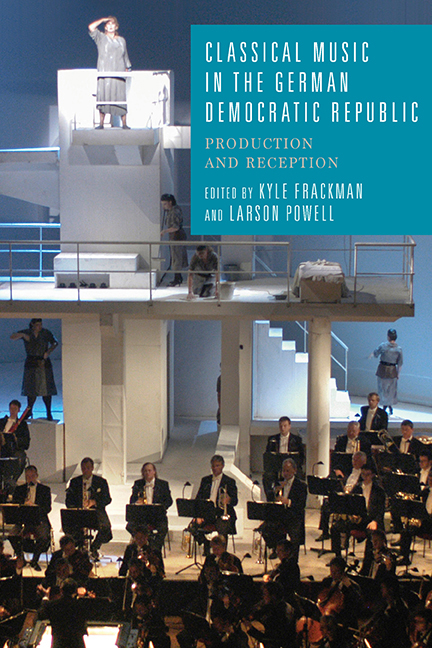Book contents
- Frontmatter
- Contents
- Acknowledgments
- List of Abbreviations
- Introduction: Music and Heritage in the German Democratic Republic
- 1 Provincialism, Modernity, and the Classical Heritage: The Administrative Structure of the GDR and the Situation of Music Production
- 2 Classicism as Anti-Fascist Heritage: Realism and Myth in Ernst Hermann Meyer’s Mansfelder Oratorium (1950)
- 3 Positioning Georg Knepler in the Musicological Discourse of the GDR
- 4 Ehrt euren Deutschen Meister: Reproducing Wagner in the GDR
- 5 The Embodiment of Collective Memory in Neue Odyssee
- 6 Marxism and Feminism in Ruth Berghaus’s Staging of Don Giovanni
- 7 Beyond the Gewandhaus: Mahler and the GDR
- 8 Hanns Eisler’s Funeral and Cultures of Commemoration in the GDR
- 9 Exile—Remigration—Socialist Realism: The Role of Classical Music in the Works of Paul Dessau
- 10 “What a Satisfying Task for a Composer!”: Paul Dessau’s Music for The German Story (. . .Du und mancher Kamerad)
- 11 Friedrich Schenker and the Third Way
- 12 A Prism of East German Music: Lothar Voigtländer
- Notes on the Contributors
- Index
8 - Hanns Eisler’s Funeral and Cultures of Commemoration in the GDR
Published online by Cambridge University Press: 21 May 2021
- Frontmatter
- Contents
- Acknowledgments
- List of Abbreviations
- Introduction: Music and Heritage in the German Democratic Republic
- 1 Provincialism, Modernity, and the Classical Heritage: The Administrative Structure of the GDR and the Situation of Music Production
- 2 Classicism as Anti-Fascist Heritage: Realism and Myth in Ernst Hermann Meyer’s Mansfelder Oratorium (1950)
- 3 Positioning Georg Knepler in the Musicological Discourse of the GDR
- 4 Ehrt euren Deutschen Meister: Reproducing Wagner in the GDR
- 5 The Embodiment of Collective Memory in Neue Odyssee
- 6 Marxism and Feminism in Ruth Berghaus’s Staging of Don Giovanni
- 7 Beyond the Gewandhaus: Mahler and the GDR
- 8 Hanns Eisler’s Funeral and Cultures of Commemoration in the GDR
- 9 Exile—Remigration—Socialist Realism: The Role of Classical Music in the Works of Paul Dessau
- 10 “What a Satisfying Task for a Composer!”: Paul Dessau’s Music for The German Story (. . .Du und mancher Kamerad)
- 11 Friedrich Schenker and the Third Way
- 12 A Prism of East German Music: Lothar Voigtländer
- Notes on the Contributors
- Index
Summary
WHEN THE EAST GERMAN COMPOSER Hanns Eisler passed away on September 6, 1962, Lilly Becher stated that “Hanns Eislers bleibendes Denkmal ist die Melodie seines Lebens. Sie ist ‘als namenloses Lied’ eine Melodie des Volkes geworden. Sie begleitet als revolutionäres Kampflied den Aufbruch der Massen in die Zukunft.” (Eisler's enduring monument is the melody of his life, which has become a “nameless song,” a melody of the people. As a revolutionary Kampflied [song of struggle] it accompanies the uprising of the masses into the future.) Written by the wife of the former culture minister and Eisler's collaborator for the East German national anthem Johannes R. Becher (who had died four years prior), this eulogy was published at the center of a multipage tribute to Hanns Eisler that appeared in Neues Deutschland, the official newspaper of the SED, on September 9, 1962. The tribute consisted of reflections from Eisler's colleagues, friends, and counterparts from home and abroad, who collectively mourned the death of “unser Hanns Eisler” (our Hanns Eisler). Used in Neues Deutschland and other state-sanctioned publications, these epitaphs served to reinforce a stylized image of Hanns Eisler as one of the founding fathers of East German music. Eisler's death was not just a loss for his friends, family, and coworkers, but also an occasion for national mourning.
To mark the composer's high cultural status, he was honored with a state funeral at the Staatsoper in East Berlin and buried at the Dorotheenstädtischer cemetery alongside Bertolt Brecht and Becher in the plot reserved for former members of the East German Academy of the Arts. But what made Eisler—an Austrian by birth, who kept his foreign passport even after he chose to settle in the Soviet zone after the war, and never joined the SED—an icon of East German music? What role did posthumous commemorative acts play in shaping his reputation? And how did these mourning rituals account for Eisler's unique status within the East German cultural pantheon as both the rightful (i.e., proletarian) heir to the German musical canon, and a friend, teacher, and father figure to many of the composers who participated in his commemoration?
- Type
- Chapter
- Information
- Classical Music in the German Democratic RepublicProduction and Reception, pp. 157 - 182Publisher: Boydell & BrewerPrint publication year: 2015



